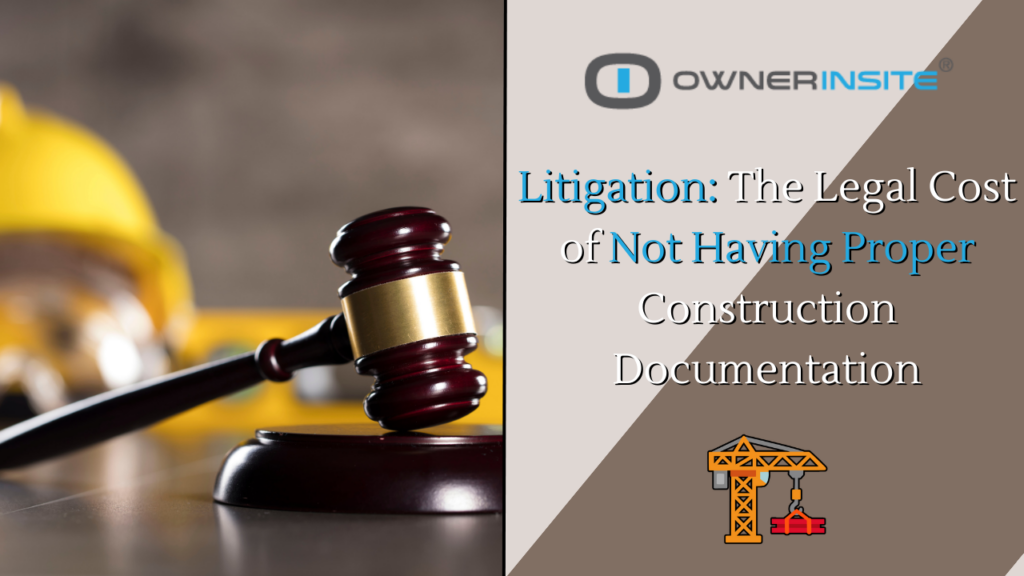Most people don’t like paperwork. It’s tedious to create, often monotonous to read, and time-consuming to file, store, record, and archive properly. You can probably add papercuts to that list if you handle paperwork and physical documentation enough. You could say that there are probably very few people who like documentation.
Unless you happen to be talking about construction professionals.
That’s because in the construction industry, if it’s not in writing, it didn’t happen, and once you’ve run into that particular problem once, you start to love writing everything down pretty quickly. Let’s examine possible outcomes without proper construction documentation and the potential hefty legal costs – possibly even months or years after the project is completed.
Statutory Document Retention
We’re going to get to the legal value of proper construction documentation and records in the event of litigation in a moment, but before we do, it’s important to remember that State and Federal government agencies also have statutory document retention periods that you must comply with – and if you don’t, you could face fines and other penalties.
The construction documentation retention period depends on the government department or agency, but there are rules about health and safety records, financial records, close-out documentation, and more.
There could be severe consequences if you ever face inquiries or inspections by one of those government departments and agencies and can’t produce the required documentation for any project. So, it’s always best to double-check all the statutory document retention requirements that apply to your projects and make sure you keep everything close at hand.
Litigation and Construction Documentation
Many project owners and even construction professionals see the completion of any project as a full stop that puts an end to everything related to that project. However, responsibility and liability can extend for months and even years after the last construction crew leaves the site and the tenant or occupant moves into the building.
Latent defects, delayed workplace injuries and illnesses, and design flaws can all come to light after completing a project. In many cases, the statute of limitations may not have run out. This means you could find yourself being sued a long time after you thought a project was in the history books.
Discovery, Burden of Proof and More
When construction projects become the focus of a lawsuit, it’s usually very serious. Most people and organizations aren’t willing to take on the stress, expense, and work that goes into a construction-related lawsuit. So, they usually only approach a lawyer when it’s necessary.
That also usually means significant amounts of money are at stake; sometimes, there may be criminal and civil ramifications.
The last thing any project owner ever wants is to be the subject of a lawsuit. Still, if you are, your construction documentation will be of critical importance for several reasons, including:
- During discovery, you will be required to provide records and documents when requested– and not having those records could trigger other statutory investigations, as we’ve already mentioned
- When you are subject to any construction-related lawsuit as the project owner or developer, the onus will often be on your organization to prove that the claims made are invalid. Usually, the only way to do that is by producing a paper trail showing the facts.
- Suppose you are involved in a warranty-related lawsuit. In that case, you may be required to prove that another party is responsible for the material or structure in question, which would require you to produce their warranty documentation.
Regardless of what kind of lawsuit you and your construction project are the targets of, having documented evidence that proves you have met all your obligations and followed all required procedures and processes might be the difference between a costly loss or victory during mediation or trial.
How Much Can Construction Lawsuits Cost?
Paperwork could be more exciting. Setting up and managing document storage and archiving systems is tedious and time-consuming, and it might be tempting just to put it all in bankers’ boxes and hope for the best. However, when you look at the settlement figures in some construction-related lawsuits, there’s a very clear business case for doing the opposite.
One recent case involving latent defects in the construction of 432 Park Avenue – a luxury condo development in New York City – is claiming $125 million in damages from the developers.
In 2003, the parking garage of the Tropicana Casino collapsed during construction, killing four and injuring another 21. The court found that design flaws caused the collapse, and the defendants (including the Tropicana Casino) settled for $101 million.
While these cases are not typical of every construction-related lawsuit, they are a clear warning to everyone involved that large sums of money are at stake if something goes wrong.
Of course, proper construction documentation alone won’t absolve you from responsibility if a court finds that there was negligence or that cutting corners was the reason something went wrong. But as the project owner, provided you have met your obligations and done your due diligence and can prove it, it may well insulate you from the worst outcomes.
Construction Document Retention Best Practices for Project Owners
As a construction project owner or developer, it’s highly probable that you are not a construction professional or a lawyer. So, you might not know what kind of documentation you might need one day to produce if you are ever involved in a construction-related lawsuit.
That’s why, when it comes to proper construction documentation and retention best practices, we believe that the safest and most prudent course of action is to keep all construction documents for at least your state statutory minimum retention requirements. However, in many cases, you may want to retain the documents for considerably longer than that. You can find your state requirements here: constructionlitigationhold.com
While there are limitations on when lawsuits can be filed, in some cases, these limitations start from the time the plaintiff becomes aware of the problem – which could be months or years after a construction project is finished. Latent defects might also only become apparent a long time after a project is finished, and depending on the seriousness of the problem, you might still need to defend yourself in court. It all starts with the contract between parties. Read more about contracts here.
Keeping physical construction documents and records for every project is often impractical, but now that we can store them securely in the cloud, organize them easily, and access them when we need to with tools like Owner Insite, we recommend keeping digital construction records indefinitely, particularly for large or complex projects.
With digital record keeping on Owner Insite, even when a project is closed and archived, you always have the security of having all your important records at your fingertips when you need them, without having to deal with papercuts and dusty boxes.
To learn more about how we help protect your interests and safeguard all your data, reach out to us at 888-336-3393 or sales@owner-insite.com




